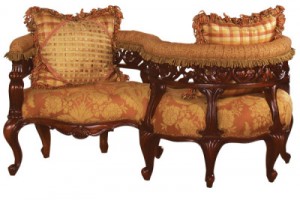
At first glance, it seems as though you’d benefit more from a translation than a definition. It’s a fair assumption. We won’t leave you hanging though. Tête-à-tête is French for head-to-head.
However, like many things with the French language, to provide or generate a literal translation would only serve to take away from the beauty and mystique of the term.
Translation consensus aside, it would at least help to know how it it pronounced. For those interested in the details, tête-à-tête is pronounced (tet-ə-ˈtet). In English, we know it as a courting bench.
The tête-à-tête takes the loveseat concept to a completely different level.
Leave it to the French, creators of the city of love, to develop such a thing.
As the English title would imply, the courting bench was designed for two individuals to be able to sit on a bench next to one another while being able to comfortably turn and face the other.
This helped encourage intimacy and sincerity of conversation while clearly setting boundaries on how for the exchange would go, at least at that specific location.
Although, the pictured tête-à-tête is more of a traditional design, modern furniture designers have taken it on worth success.
While having a seating arrangement that allows for conversation and nothing more is a teenager’s dream, it’s sad to say they aren’t very practical in the home setting.
